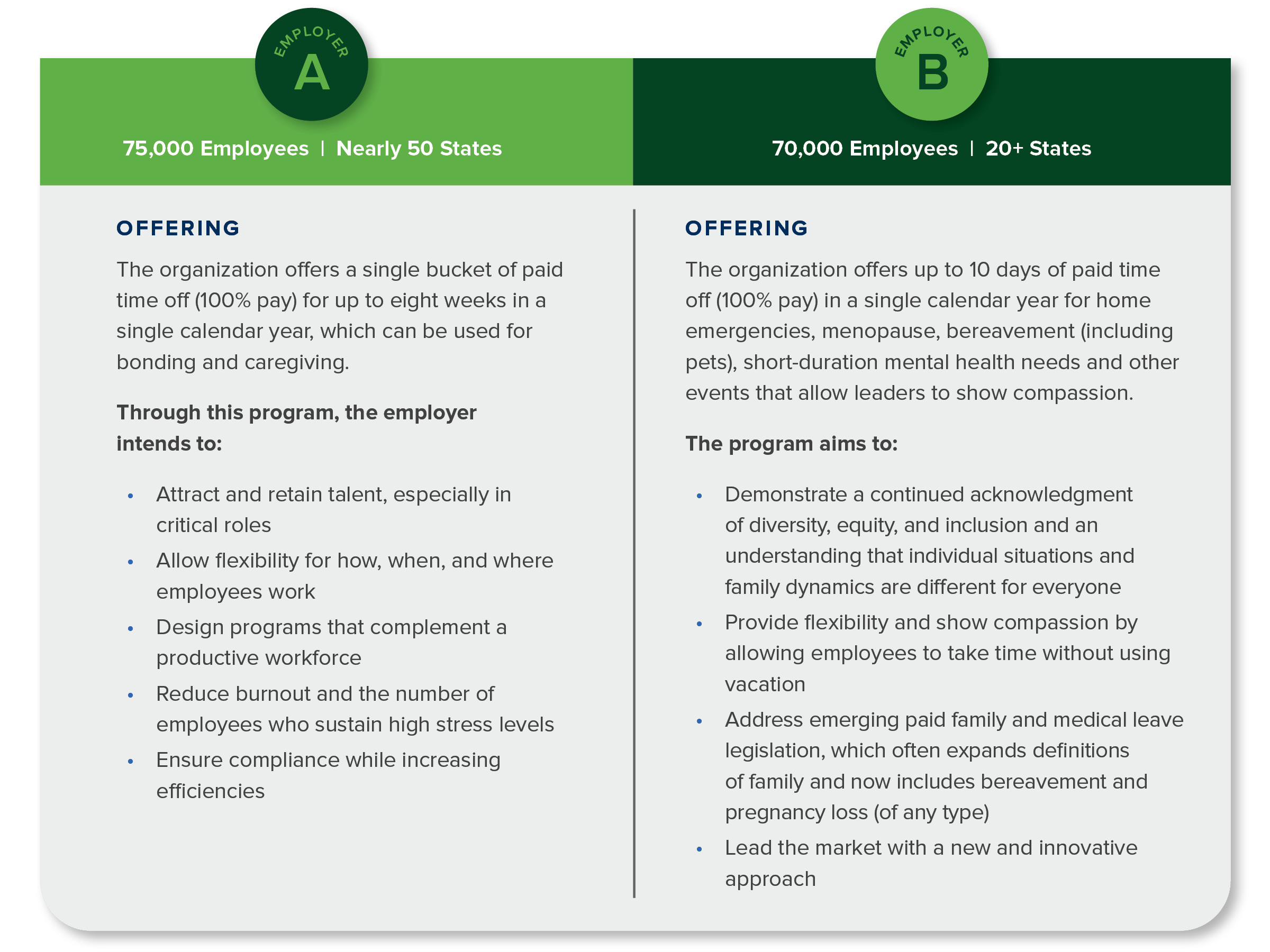Employee Benefits
The Business Case for Inclusive Leave Programs
The Business Case for Inclusive Leave Programs
The current environment in 2025 as it relates to diversity, equity and inclusion (DEI), both in the workplace and more broadly, has rapidly shifted with the change in administration. While some employers have scaled back their formal DEI initiatives, others have strengthened their commitment. Although legal protections for protected classes remain in place, the visibility of structured DEI efforts may have diminished. Regardless of official organizational positions, most individuals within human resources and benefits departments still believe in the value of DEI across race, age, gender, sexuality and disability. Leave programs, in particular, stand out as a tangible way for employers to demonstrate their commitment to equity by implementing policies that provide meaningful support to diverse employee needs.
As human resources professionals, we are entrusted with company culture, holistic health and well-being. Too often, tensions run high, and we find ourselves navigating a profound sea of policy and practice changes. One grounding reference point to help at each turn is incorporating a central goal of fostering equitable, inclusive work environments that represent as many employee populations as possible, including age, identified gender and sexuality. An often overlooked, yet enormously impactful, area of inclusivity in action is benefit and leave policy design.
These are practical realities. Equitable, inclusive policies are a strategic necessity for employers to achieve recruitment and retention goals today. These policies will become increasingly important given that Generation Z is the largest workforce on record (expected to reach 30% of the U.S. workforce by 2030)1 and the most diverse.
According to the U.S. Chamber of Commerce Foundation, nearly 60% of companies focusing on LGBTQ+ inclusive practices have better applicant pools, and 53% have higher employee retention rates.2
In addition to recruitment and retention, inclusive benefit policies reduce liability. Title VII of the Civil Rights Act of 1964 protects employees against discrimination based on sexual orientation or transgender status.3 It prohibits discrimination when providing fringe benefits, which include medical, hospital, accident, life insurance and retirement plans; profit-sharing; bonus plans; leave; and other terms, conditions and privileges of employment. Since the LGBTQ+ community constitutes 5.9% of the U.S. workforce, employers should include benefits supporting these employees.4
Design Strategy
Employers may think they understand the benefits employees crave, but employee data may indicate otherwise. When reviewing your organization’s benefit policies, start by analyzing existing leave and disability program data to learn which types of leave employees are using. Remember that data may not tell the complete story, especially for those individuals whose leave needs do not align with traditional leave types.
Using surveys to ask employees what they want and need can reveal valuable information and insight into how employers can improve the effectiveness and efficiency of leave programs. Collaborate with your diversity, equity, inclusivity, belonging and accessibility (DEIBA) team and leaders of internal LGBTQ+ employee resource groups (ERGs) when you design a survey to assess whether you are asking the right questions and if employees will feel comfortable responding.
Reconsidering Paid Leave
Most U.S. employers with more than 100 employees offer traditional disability, sick and vacation time. Many offer paid maternity and/or parental leave and some generous employers offer paid caregiver leave. The intent is to ensure employees have the necessary time across a broad spectrum of leave reasons and family definitions.
Are the programs truly inclusive? Consider traditional maternity/parental benefits, which help younger workers starting families, but often exclude other family planning strategies. To ensure inclusivity, expand the scope to include paid leave for adoption or surrogacy and even time off to recover from permanent birth control procedures, as the choice to not have children is considered family planning.
In addition to family planning, consider adding domestic and/or life partners as covered relationships within paid time off programs to care for loved ones. Assess whether paid leave programs include mental health conditions in meaningful ways. Nearly one-fifth of U.S. workers (19%) rated their mental health as fair or poor, with about four times more unplanned absences due to poor mental health than their counterparts who report good, very good or excellent mental health.5 More than 60% of 543 members of the LGBTQ+ community between the ages of 18 and 25 years claimed fair or poor mental health.6
While most disability benefits cover a mental health diagnosis, how much time away is allocated? How easy is it for employees to access and use the benefits? As employers continue to see increases in mental health disability claims, it is time to review employee assistance programs (EAP) and revise their design to help provide meaningful and comprehensive care.
For example, do your programs include free visits with a wide variety of practitioners, including those with experience working with the LGBTQ+ community? Could they? How many employees know what is available? Consider the monetary investment for those EAPs and advertise the programs like your mental health depends on it. Take it a step further and allow employees to use sessions with EAP providers to substantiate their disability benefits, for at least the initial approval of benefits.
Unrealistic Expectations?
Addressing every employee’s need for leave within company policies may not be possible. Employees are asking for paid leave for everything from natural disaster leave to grandparent, “pawternity” and menopause leave. It’s challenging to provide leave for all while still running a business. However, forward-thinking employers are creating more encompassing compassionate leave programs that allow time away for a multitude of reasons, which is inclusive of diverse employee populations. There is growing interest in the compassionate leave model as employers evaluate organizational goals, employee wants and needs, design potential and associated costs.
Below are two examples of multistate employers that adopted compassionate leave programs, which have been well-received by employees and leadership.

Inclusive Policy Language
In addition to creating new types of leave and broadening existing leave types, some employers and states are removing gender pronouns from policies and handbooks in favor of more gender-neutral terms, such as they, their and them. By incorporating more inclusive and intentional language into leave policies, employers ensure programs are more equitable and accessible, regardless of gender.
This work also helps support legal compliance. The Department of Labor and the federal government have adopted anti-discrimination policies regarding gender identity by recognizing that discrimination based on gender identity or expression is sex discrimination.7
The need for this type of protection is real. A study by the National Center for Transgender Equality8 indicated that most transgender respondents hid their gender transition or quit their jobs to avoid mistreatment at work. Nearly half of the study respondents did not ask their employers to refer to them with the correct pronouns (he, she or they) out of fear of discrimination. The second iteration of this study, reinforced why terms like “nonbinary” and “female-bodied” are becoming more prevalent in company policy language.9 This data illustrates the need for more attention to awareness of diverse employee needs, especially considering how a person’s sense of belonging influences employee productivity and tenure with organizations.
That is one reason many companies have established gender-neutral policies, such as paid family leave programs that support all employees. The most recent policies use terms like parental, birth parent or nonbirth parent. These programs provide equal paid leave time for new parents following the birth or adoption of a child and continue to accommodate evolving gender stereotypes that affect the LGBTQ+ community. Gender-neutral language intentionally acknowledges that family units come in many shapes and sizes, regardless of gender, sex or identity.
As you evaluate policies for gender-neutral language, consider engaging with DEIBA partners and ERGs to understand your population’s specific needs and what success looks like regarding adoption and/or acceptance of changes. Also, explore opportunities to use more inclusive language within programs managed by vendors, such as allowing options other than male and female to designate gender when accessing benefit programs.
Successful Marketing
The way employer benefits are advertised influences your organization’s ability to recruit and retain young talent. While early post-pandemic studies confirmed employees were using more paid time off, employers should promote and encourage the use of paid time off programs and combat negative perceptions to help employees overcome stress. This could be especially important for the LGBTQ+ community, particularly if your traditional leave program doesn’t appear to cover their reasons for leave. Consider employer disability plan and policy language. Consider the experience of a transgender employee trying to understand if they have access to income and job protection while receiving and recovering from critical transition care. Does their care fall under common cosmetic exclusions in a disability plan? Is their care considered elective and subject to preapproval for leave from supervisors?
Ensure that your policies are clearly written and that employees understand them. Focus on facilitating positive conversations, providing support structures and modeling healthy approaches to taking time off.
- Advertise benefit programs at regular intervals throughout the year
- Ensure leaders are aware of benefit programs and encourage employees to use them
- Ask leaders across the organization to talk about program offerings and provide incentives to leaders who take time away and share their experiences
- Post about your unique benefit offerings on social media\
Integrating DEIBA into your benefit policies fosters belonging and respect. By prioritizing these values, employers can unlock employees’ full potential, drive innovation, increase productivity and ensure long-term success.
1 U.S. Bureau of Labor Statistics. Labor Force Statistics from the Current Population.
2 Kumar, Vibha Sathesh. “Gen Z in the Workplace: How Should Companies Adapt?” Imagine. Johns Hopkins University. April 18, 2023.
3 U.S. Supreme Court. Bostock v Clayton County, Georgia. Oct. 8, 2019.
4 Bowdish, Lawrence, and Zellner, Sara. “Business Success and Growth Through LGBT-Inclusive Culture.” U.S. Chamber of Commerce Foundation. April 9, 2019.
5 Sears, Brad, et al. “Public and Private Sector Employees’ Perceptions of Discrimination Against LGBTQ People.” Williams Institute, UCLA School of Law. April 12, 2021.
6 Witters, Dan, and Sangeeta Agrawal. “The Economic Cost of Poor Employee Mental Health.” Workplace. Gallup. July 21, 2023.
7 Marken, Stephanie. “LGB Gen Z Members More Anxious and Stressed Than Peers.” News. Gallup. Nov. 21, 2023.
8 National Center for Transgender Equality. 2015 U.S. Transgender Survey.
9 Carter, Kelly. “The Hartford’s New Study Finds Nearly Half of LGBTQ+ Workers’ Mental Health at Work Affected by News, Current Events, Less Likely to Seek Care.” June 21, 2023.
* 2022 survey results were not yet available as of the date of this article.

Ali Schaafsma
Director, Absence Consulting

Melanie Payton, CLMS, AVP
Absence Consulting and Audit Practice
